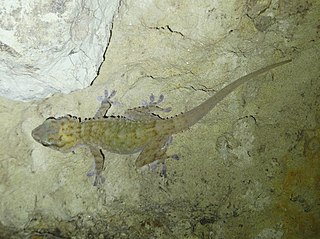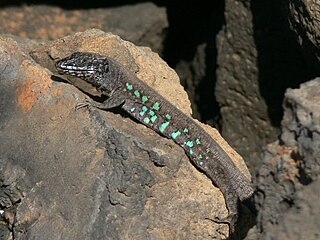
The Canary Islands stonechat, also known as the Fuerteventura stonechat or Fuerteventura chat, and formerly known as the Canary Islands chat due to its once widespread distribution on the Canary Islands, is a sedentary resident bird found only on the island of Fuerteventura where it is known as the Caldereta.

Tarentola mauritanica, known as the common wall gecko, is a species of gecko (Gekkota) native to the western Mediterranean area of North Africa and Europe. It has been introduced to Madeira and Balearic Islands, and the Americas. A nocturnal animal with a predominantly insectivorous diet, it is commonly observed on walls in urban environments in warm coastal areas; it can be found further inland, especially in Spain where it has a tradition of cohabitation with humans as an insect hunter. A robust species, up to 15 centimetres (5.9 in) long, its tubercules are enlarged and give the species a spiny armoured appearance.

The helmethead gecko, also known commonly as the helmeted gecko, is a species of lizard in the family Phyllodactylidae. The species is native to the northwestern coast of Africa, where it is present in Mauritania, Morocco, and Western Sahara. The environment in which this gecko lives is sandy and rocky desert with sparse vegetation, in a zone near the coast where the humidity is high.

The Madeiran wall lizard is a species of lizard in the family Lacertidae. It is the only species in the genus Teira. The species is endemic to the Madeira Archipelago, Portugal. In the Azores, this lizard has become naturalized after involuntary introduction by the shipping trade between the two archipelagos. There are four recognized subspecies. The species is both endemic and common, ranging from sea coasts to altitudes of 1,850 metres (6,070 ft). It is usually found in rocky places or among scrub and may climb into trees. It is also found in gardens and on walls. It feeds on vegetable matter and small invertebrates such as ants. The tail is easily shed and the stump regenerates slowly. The colouring is variable and tends to match the surroundings, typically a shade of brown or grey with occasionally a greenish tinge. Most animals are finely flecked with darker markings. The underparts are white or cream, sometimes with dark spots, with some males having orange or red underparts and blue throats, but these bright colours may fade if the animal is disturbed. The Madeiran wall lizard grows to a snout-to-vent length of about 8 cm (3.1 in) with a tail about 1.7 times the length of its body. Females lay two to three clutches of eggs in a year with the juveniles being about 3 cm (1.2 in) when they hatch.

The Fuerteventura skink is an endangered ovoviviparous species of skink in the family Scincidae. Skinks are generally characterized by their smaller legs and less pronounced necks compared to typical lizards.

Böhme's gecko, also commonly known as the Morocco wall gecko, is a species of lizard in the family Phyllodactylidae. The species is native to western North Africa, where it is found in rocky areas such as cliffs and walls as well as ruins of buildings and urban areas.

Boettger's wall gecko, also commonly known as the Gran Canaria gecko, is a species of lizard in the family Phyllodactylidae. The species is native to the Canary Islands and the Savage Islands. There are three recognized subspecies.

The Tenerife gecko, also known commonly as Delalande's gecko and the Tenerife wall gecko, is a species of lizard in the family Phyllodactylidae.

The Gomero wall gecko or La Gomera gecko, also known as perenquén in the Canary Islands, is a species of lizard in the family Phyllodactylidae. It is endemic to La Gomera.
The Qattara gecko is a species of lizard in the family Phyllodactylidae.

The Atlantic lizard is a species of lizards in the family Lacertidae. It is endemic to the eastern Canary Islands Lanzarote and Fuerteventura and the smaller islands surrounding them.

The Anatolian rock lizard is a species of lizard in the family Lacertidae. It is found in western Anatolia and on islands off the coast, where its natural habitats are temperate forests and rocky areas. A common species, the IUCN has listed it as being of "least concern".

The Greek rock lizard is a species of lizard in the family Lacertidae. Endemic to Greece, its natural habitats are temperate forests, Mediterranean-type shrubby vegetation, rocky areas, and pastureland. It is threatened by habitat loss.The International Union for Conservation of Nature has listed it as being "near threatened".

The sharp-snouted rock lizard is a species of lizard in the family Lacertidae. It is found in Bosnia and Herzegovina, Croatia, Montenegro, and possibly Albania, where its natural habitats are Mediterranean-type shrubby vegetation, rocky areas, rocky shores, rural gardens, and urban areas.

The Peloponnese wall lizard is a species of lizard in the family Lacertidae. It is endemic to the Peloponnese region of southern Greece. Its natural habitats are Mediterranean-type shrubby vegetation, rocky areas, arable land, pastureland, plantations, and rural gardens.

The Ibiza wall lizard is a species of lizard in the family Lacertidae. It is most closely associated with the island of Eivissa, or Ibiza, in the Balearic Islands, but has become naturalized in parts of Spain.
Darwin's wall gecko is a species of lizard in the family Phyllodactylidae. The species is endemic to Cape Verde, where it occurs on the islands of São Nicolau, Sal, Santiago, and Fogo.

Diplodactylus conspicillatus, also known commonly as the variable fat-tailed gecko or the burrow-plug gecko, is a species of lizard in the family Diplodactylidae. The species is endemic to Australia, where it is found in central and arid inland areas. Widespread across the continent, the variable fat-tailed gecko is most commonly found in sandy desert habitats dominated by spinifex grasses. It has also been bred in captivity by zoos and as pets.
Crombie's wall gecko, also known commonly as the Oriente tuberculate gecko, is a species of lizard in the family Phyllodactylidae. The species is endemic to Cuba.

The wildlife of Spain includes the diverse flora and fauna of Spain. The country located at the south of France has two long coastlines, one on the north on the Cantabrian Sea, another on the East and South East on the Mediterranean Sea, and a smaller one on the west and south west on the Atlantic Ocean, its territory includes a big part of the Iberian Peninsula, the Canary Islands, the Balearic Islands and two enclaves in North Africa, Ceuta and Melilla. and the different climate zones, Spain is one of the countries in Europe with the greatest biodiversity.


















